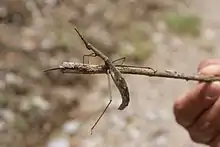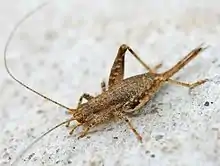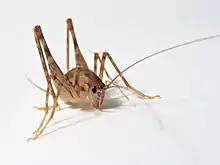Orthoptera
Orthoptera (Ancient Greek ὀρθός (orthós, “straight”) + πτερά (pterá, “wings”)) is an order of insects that comprises the grasshoppers, locusts and crickets, including closely related insects such as the katydids and wētā. The order is subdivided into two suborders: Caelifera – grasshoppers, locusts and close relatives; and Ensifera – crickets and close relatives.
| Orthoptera | |
|---|---|
_male.jpg.webp) | |
| Roesel's bush-cricket family Tettigoniidae | |
| Scientific classification | |
| Kingdom: | Animalia |
| Phylum: | Arthropoda |
| Class: | Insecta |
| Superorder: | Orthopterida |
| (unranked): | Panorthoptera |
| Order: | Orthoptera Latreille, 1793 |
| Extant suborders and superfamilies | |
|
Suborder Ensifera Suborder Caelifera | |
More than 20,000 species are distributed worldwide.[1] The insects in the order have incomplete metamorphosis, and produce sound (known as a "stridulation") by rubbing their wings against each other or their legs, the wings or legs containing rows of corrugated bumps. The tympanum or ear is located in the front tibia in crickets, mole crickets, and katydids, and on the first abdominal segment in the grasshoppers and locusts.[2] These organisms use vibrations to locate other individuals.
Grasshoppers and other orthopterans are able to fold their wings (i.e. they are members of Neoptera), and they are frequently grouped with similar "Orthopteroid" insect orders.
Etymology
The name is derived from the Greek ὀρθός orthos meaning "straight" and πτερόν pteron meaning "wing".
Characteristics
Orthopterans have a generally cylindrical body, with elongated hindlegs and musculature adapted for jumping. They have mandibulate mouthparts for biting and chewing and large compound eyes, and may or may not have ocelli, depending on the species. The antennae have multiple joints and filiform type, and are of variable length.[2]
The first and third segments on the thorax are larger, while the second segment is much smaller. They have two pairs of wings, which are held overlapping the abdomen at rest. The forewings, or tegmina, are narrower than the hindwings and hardened at the base, while the hindwing is membranous, with straight veins and numerous cross-veins. At rest, the hindwings are held folded fan-like under the forewings. The final two to three segments of the abdomen are reduced, and have single-segmented cerci.[2]
Life cycle
Orthopterans have a paurometabolous lifecycle or incomplete metamorphosis. The use of sound is generally crucial in courtship, and most species have distinct songs.[3] Most grasshoppers lay their eggs in the ground or on vegetation. The eggs hatch and the young nymphs resemble adults, but lack wings and at this stage are often called 'hoppers'. They may often also have a radically different coloration from the adults. Through successive moults, the nymphs develop wings until their final moult into a mature adult with fully developed wings.[2]
The number of moults varies between species; growth is also very variable and may take a few weeks to some months depending on food availability and weather conditions.
Evolution
This order evolved 300 million years ago with a division into two suborders - Caelifera and Ensifera - occurring 256 million years ago.[4]
Phylogeny
The Orthoptera is divided into two suborders, Caelifera and Ensifera (crickets) which have been shown to be monophyletic.[5][6][7]
| Orthoptera |
| ||||||||||||||||||||||||||||||||||||||||||||||||||||||||||||||||||
Taxonomy
.jpg.webp)

Taxonomists classify members of the Caelifera and Ensifera into infraorders and superfamilies as follows:[8][9][10]
- Suborder Caelifera – grasshoppers, pygmy mole crickets and allies
- Infraorder Acrididea
- Superfamily Acridoidea – grasshoppers, locusts
- Superfamily Eumastacoidea – monkey or matchstick grasshoppers and allies
- Superfamily Locustopsoidea†
- Superfamily Pneumoroidea – bladder grasshoppers
- Superfamily Pyrgomorphoidea – gaudy grasshoppers
- Superfamily Tanaoceroidea – desert long-horned grasshoppers
- Superfamily Tetrigoidea – ground-hoppers or grouse locusts
- Superfamily Trigonopterygoidea – leaf grasshoppers
- Infraorder Tridactylidea
- Superfamily Dzhajloutshelloidea†
- Superfamily Regiatoidea†
- Superfamily Tridactyloidea – pygmy mole crickets and allies
- Infraorder Acrididea
- Suborder Ensifera – crickets
- Superfamily Grylloidea – crickets, mole crickets
- Superfamily Hagloidea – grigs and allies
- Superfamily Phasmomimoidea†
- Superfamily Rhaphidophoroidea – camel crickets, cave crickets, cave wētā
- Superfamily Schizodactyloidea – dune crickets
- Superfamily Stenopelmatoidea – wētā and allies
- Superfamily Tettigonioidea – katydids / bush crickets
Relationships with humans
As pests
Several species of Orthoptera are considered pests of crops and rangelands or seeking warmth in homes by humans. The two species of Orthoptera that cause the most damage are grasshoppers and locusts. Locust are historically known for wiping out fields of crops in a day. Locust have the ability to eat up to their own body weight in a single day.[11] Individuals gather in large groups called swarms, these swarms can range up to 80 million individuals that stretch 460 square miles.[11] Grasshoppers can cause major agricultural damage but not to the documented extent as locust historically have. These insects mainly feed on weeds and grasses, however, during times of drought and high population density they will feed on crops. They are known pest in soybean fields and will likely feed on these crops once preferred food sources have become scarce.[12]
As food
The Orthoptera include the only insects considered kosher in Judaism. The list of dietary laws in the book of Leviticus forbids all flying insects that walk, but makes an exception for certain locusts. Strangely, the dragonfly and cranefly are not kosher, but they are helpless when unable to fly.[13] The Torah states the only kosher flying insects with four walking legs have knees that extend above their feet so that they hop.[14] Thus nonjumping Orthoptera such as mole crickets are certainly not kosher.
As creators of biofuel
With new research showing promise in locating alternative biofuel sources in the gut of insects, grasshoppers are one species of interest. The insect's ability to break down cellulose and lignin without producing greenhouse gases has aroused scientific interest.[15]
See also
- List of Orthoptera recorded in Britain
- Orthopterida
- Female sperm storage
References
- "Orthoptera - Grasshoppers, Locusts, Crickets, Katydids". Discover Life. Retrieved 2017-09-06.
- Hoell, H.V., Doyen, J.T. & Purcell, A.H. (1998). Introduction to Insect Biology and Diversity, 2nd ed. Oxford University Press. pp. 392–394. ISBN 978-0-19-510033-4.CS1 maint: multiple names: authors list (link)
- Imes, Rick (1992), The practical entomologist, Simon and Schuster, pp. 74–75, ISBN 978-0-671-74695-7
- Chang H, Qiu Z, Yuan H, Wang X, Li X, Sun H, Guo X, Lu Y, Feng X, Majid M, Huang Y (2020) Evolutionary rates of and selective constraints on the mitochondrial genomes of Orthoptera insects with different wing types. Mol Phylogenet Evol
- Zhou Z, Ye H, Huang Y, Shi F. (2010) The phylogeny of Orthoptera inferred from mtDNA and description of Elimaea cheni (Tettigoniidae: Phaneropterinae) mitogenome. J. Genet. Genomics. 37(5):315-324
- Gwynne, Darryl T. (1995). "Phylogeny of the Ensifera (Orthoptera): a hypothesis supporting multiple origins of acoustical signalling, complex spermatophores and maternal care in crickets, katydids, and weta". Journal of Orthoptera Research. 4 (4): 203–218. doi:10.2307/3503478. JSTOR 3503478.
- Flook, P. K.; Rowell, C. H. F. (1997). "The Phylogeny of the Caelifera (Insecta, Orthoptera) as Deduced from mtrRNA Gene Sequences". Molecular Phylogenetics and Evolution. 8 (1): 89–103. doi:10.1006/mpev.1997.0412. PMID 9242597.
- "Orthoptera Species File Online" (PDF). University of Illinois. Retrieved 6 January 2018.
- Blackith, RE; Blackith, RM (1968). "A numerical taxonomy of Orthopteroid insects". Australian Journal of Zoology. 16 (1): 111. doi:10.1071/ZO9680111.
- Flook, P. K.; Klee, S.; Rowell, C. H. F.; Simon, C. (1999). "Combined Molecular Phylogenetic Analysis of the Orthoptera (Arthropoda, Insecta) and Implications for Their Higher Systematics" (PDF). Systematic Biology. 48 (2): 233–253. doi:10.1080/106351599260274. ISSN 1076-836X. PMID 12066707.
- Society, National Geographic. "Locusts, Locust Pictures, Locust Facts - National Geographic". National Geographic. Retrieved 2016-04-11.
- Krupke, Christian. "Grasshoppers | Pests | Soybean | Integrated Pest Management | IPM Field Crops | Purdue University". extension.entm.purdue.edu. Retrieved 2016-04-11.
- Gordon, David George (1998), The eat-a-bug cookbook, Ten Speed Press, p. 3, ISBN 978-0-89815-977-6
- Navigating the Bible: Leviticus
- Shi, Weibing; Xie, Shangxian; Chen, Xueyan; Sun, Su; Zhou, Xin; Liu, Lantao; Gao, Peng; Kyrpides, Nikos C.; No, En-Gyu (January 2013). "Comparative Genomic Analysis of the Endosymbionts of Herbivorous Insects Reveals Eco-Environmental Adaptations: Biotechnology Applications". PLOS Genetics. 9 (1): e1003131. doi:10.1371/journal.pgen.1003131. PMC 3542064. PMID 23326236.
External links
| Wikimedia Commons has media related to Orthoptera. |
| Wikispecies has information related to Orthoptera. |
- Orthoptera Species File Online
- Orthoptera Image Gallery (Iowa State University Entomology Department)
- Australian Plague Locust Commission
- The Orthopterists' Society
- AcridAfrica, les acridiens d'Afrique de l'Ouest
- . New International Encyclopedia. 1905.
- Birdwing Grasshoppers in Belize
- Sound recordings of Orthoptera at BioAcoustica


.jpg.webp)
